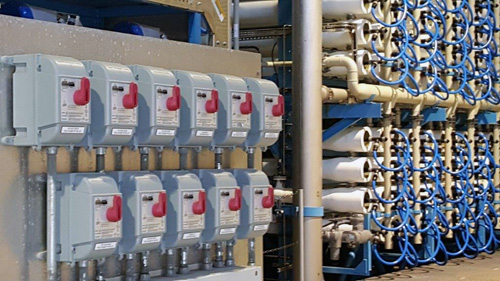
By Eva Trieger

CARLSBAD, California–Even Noah’s Ark may not be able to withstand the deluge of desalinated drinking water created daily by the joint venture of Poseidon Water and the San Diego County Water Authority. Monday, December 14th, saw media, journalists, photographers and local politicians, flooding in to witness the grand opening of the largest desalination plant in the United States.
This historic day was awash in excitement as the twenty year project hit its high tide mark. In 1991 California experienced a severe drought that left planners high and dry. The plight led to conservation and recycling, but nothing on the order required by Southern Californians. The Carlsbad desalination plant sought to create a drought proof source of drinking water that would benefit 400,000 people while bringing no harm to the marine life.
With a goal of making Southern California’s drinking water supply self-reliant, San Diego Water Autority and 24 agencies united in designing a plant that produces 50 million gallons of fresh water a day, enough to slake the thirst of about one-eighth of San Diego County’s 3.2 million water users. This means that SoCal no longer is totally dependent on snow or rain to provide for a source of fresh water, nor on water-sharing deals with Colorado or Arizona. A thirty year contract was signed between Poseidon Water and the San Diego County Authority after which time the SD Water Authority can purchase the whole operation for $1.
The blueprints for this plant have roots in Israel. The Carlsbad desalination plant was built by IDE, an Israeli company with plenty of experience in desert climates. In Israel, one of IDE’s major plant’s life expectancy is 50 years, and as Carlsbad anticipates upgrading component and improving technology, the prognosis may exceed that forecast.
Several integral folks were on hand bubbling over, with good reason, about the success of their long anticipated dream. Hope Reilly led our tour through the impressive structure and described the phases of the process before our group explored the plant. Our first stop was in “The Gut,” where we met Carlos Riva, of Poseidon Water. Riva told us that the plant is the most “advanced and the most technologically efficient.” He pointed out the 72” pipe that brings seawater in from the Pacific Ocean.
Next, Mark Weston explained that before the seawater is treated, it goes through two steps to filter out not just minerals but any bacteria or impurities. This ensures the high quality of the water coming out of the plant. From the shores of Agua Hedionda Lagoon 100 million gallons of seawater enter the plant. The intake pumps flush the seawater through anthracite, sand and gravel and then release it. Bob Yamada, Director of Resources for the SD Water Authority emphasized that this is the crucial step where other plants failed. They didn’t include this step of flocculation, where a coagulate is added to the seawater to “catch” more impurities.
Reverse Osmosis, we were told is “where the magic happens at the molecular level.” There are no less than 18 filter basins. Yamada gushed, “It is an amazing feeling to see our plan come to fruition, and know that our children can rely on this facility for a high quality water supply. It is and should be an example for other desalination projects to come.”
Neena Kuzmich, Senior Engineer with the San Diego Water Authority took us through the third phase, micronic filtration. During this step, the water undergoes microfiltration, pumped through 16 more filters. It is not yet ready for consumption because it still contains dissolved salts and minerals. During this treatment protocol, bacteria and viruses are filtered out. The Reverse Osmosis building is a bit like Willy Wonka’s factory. A maze of pressure vessels purify the water and force the water through semi-permeable membranes, siphoning out only water that is ready for the next step in becoming drinking water. The remaining water, that is not suitable for drinking will be returned to the sea.
The roughly 50% of water that will go back into the Big Drink, is largely brine, far saltier than ocean water. Before it is returned to the ocean it is mixed with seawater to reduce the salinity and make it safe for marine life.
Concerned about carbon emissions? You needn’t be because the energy recovery devices used by the plant, save approximately 146 million kilowatt hours of energy each year. The way they do this is by harnessing the high pressure stream of seawater produced during the reverse osmosis process and transfer it. That means the devices consume no energy themselves. Pretty clever, eh?
Finally a post treatment step is essential in getting the water to households around San Diego. If you’ve lived here in San Diego, you’re accustomed to our “hard water.” The desalination process removes minerals but in order to make it safe for our bodies and our pipes, disinfectants and some chlorine are added back into the water before it is piped through a ten mile, 54” pipeline to the east. The clean, tasty, desalinated water gurgles its way to San Marcos where it flows into the San Diego County Water Authority’s Second Aqueduct and eventually to the Twin Oaks Valley Water Treatment Plant. There, it is blended with imported water supplies and routed into pipes for delivery to a tap near you!
This unique, iconic water treatment plant seems to have really done its homework. The benefit to Southern Californians is obvious and immediate. Fresh water is already being supplied to Carlsbad businesses and homes. It has a lower mineral content and an “aesthetic” taste. I tried it myself, and was pleasantly surprised. Maybe we need a French name to add some panache, but the product is every bit as palatable as Perrier or Evian!
Additionally the plant is mindful of our coastal biome and Southern Californians’ sensibility to environmental concerns. The Carlsbad Desalination plant fully intends to go with the flow, and protect the wetlands and mitigate any negative marine impact, while providing a constant and stable source of fresh, energy efficient, drinking water.
Once again, we salute Israeli ingenuity. Let’s all raise a glass of desalinated water in a toast to their overflowing skill and foresight. L’Chaim!
Pingback: Rants from the Hill: A Christmas tree grows in the Nevada desert